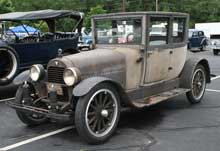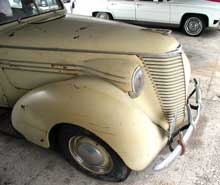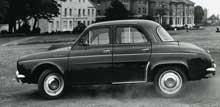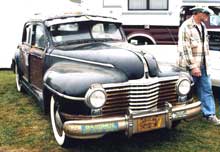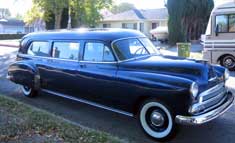Hudsons Head for Hudson
Hudson, Massachusetts, that is. For the second time in sixteen years, the Hudson Essex Terraplane Club converged on New England for a national meet, although convention headquarters were in the neighboring town of Marlborough. Hosted by HET's New England Chapter, all of last week was a Hudsonfest, with tours and seminars, memorabilia displays and meetings of the various Special Interest Groups for 55-56-57 Hudsons, the "Jet Set" and modified cars. Also on the meet agenda was the annual meeting of the very active HET Historical Society and the general meeting of the HET Club itself.
Much of the week, though, was devoted to the cars themselves. A good cross section of Hudson-badged vehicles attended. The oldest I saw was meet co-chair Carl Weber's 1915 6-54, with the distinction of the largest engine of any Hudson, 421 cubic inches, the newest an American Motors-built 1957 Hornet. In between were most variations on Hudson and both its companion makes, Essex and Terraplane. There was one example of the early four-cylinder Essex, and several of the later six cylinder models. In 1929, Essex was the third-best-selling car in America, after Ford and Chevrolet. In 1932, Hudson introduced the low-priced Terraplane, which replaced Essex the next year. The Terraplane was in turn succeeded by the entry-level Hudson 112 in 1939. From the 1930s into postwar times, Hudson also built pickups, a few of which were on show. Some of the favorite Hudsons of all time were the "Step-down" models, built from 1948-49 to 1954. Hudson's dual-carb Twin H-Power outperformed many V8s of the day.
Feature of the meet was the Hudson 8, an engine built from 1930 to 1952. Carl Weber's 1930 Super 8 roadster was a very early example of the genre, and a nice 1937 showed off its coveted translucent red ornament. Of particular interest to me were the 1927 Essex boat-tail speedster, a rare model built in '27 and '29 only, and Jerre Hoffman's 1916 Six-40, forerunner to the famous Super Six. My favorite, though, was a 1920 Model O 4-passenger coupe, a rare body style, that looked like it had just come out of a time warp. Last registered in 1932, it has the early Super Six engine and all period correct accessories. At the other end of the spectrum was a Hudson Metropolitan, a frequently-overlooked variant from the end days of the marque.
The HET Club is friendly to Hudsons that have been modified or rodded. Some of these are a bit radical, others subtly customized with odd manifestations of Twin H-Power. A nicely-done example was this "Twin H" pickup with genuine carburetion on a Step-down era 262 cubic inch engine.
A healthy flea market offered parts for all eras of the marque, as well as many restorable and driveable cars.
The Hudson Club is non-judgmental. There is no judging of cars at meets, members being encouranged to drive and enjoy their cars whatever their cosmetic state. As a result, club gatherings attract cars that are works in progress, or some, like this 1935 sedan, that haven't progressed in more than forty years. Hudsonites, as the faithful call themselves, like to drive their cars. Supporting that claim was my count of about 100 Hudsons shown on Friday, but fewer than 25 trailers in the lot.

